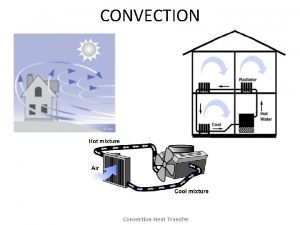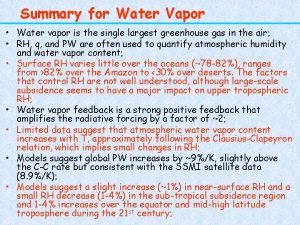Effects of Free and Forced Convection on the

- Slides: 1

Effects of Free and Forced Convection on the Convection Coefficient and Time to Steady State for Various Objects Christian Roys, Jon Zywusko, and Julie Delano Department of Chemical Engineering, University of New Hampshire Introduction Figure 1: Forced convection happens when the fluid movement is assisted by an external force such as a propeller or pump. Free convection or natural convection occurs without any additional force and the fluid movement is attributed to temperature gradients. The use of different materials and geometries can be used to determine how the heat transfer coefficient will vary with respect to different variables. Results Discussion • The heat convection coefficient forced convection is larger than the free convection for all three shapes. • The cylinder took the longest time to reach steady state. • The aluminum objects took less time to reach steady state than the brass objects. • The propeller increased the movement of the ice water and helped maintain an even temperate distribution. • The increased turbulence and even temperature distribution of the ice water led to the forced convection heat transfer coefficients to be larger than the free convection coefficients. • Figure 5 shows that the value of the convection coefficient for free and forced convection is not statistically different for brass and aluminum. • Figure 6 depicts the times to steady state for the three shapes. The main factor contributing to the different values is most likely the varying mass of the objects. Conclusion Methods The convection coefficient and time to steady state for any given object. are related to the material properties of the object and the flow of the convecting fluid. While convection increases, time to steady state decreases. Design Problem Figure 5: This bar graph shows values of the average convection coefficient for each shape and material. Bars are grouped by shape, and different treatments are separated by color. Figure 2: These objects were used in the experiment. Two brass shapes on left, and three aluminum objects on right. We were asked to scale up our findings using similar conditions to a larger aluminum sphere. By using the Lumped Heat Capacity Method, the following equation can be obtained. With the heat transfer coefficients found experimentally, as well as the Nusselt Number, the scaled up heat transfer coefficients can be calculated to find the new time. The free convection time will be 606. 9 seconds. If the water is agitated, it will lend itself to forced convection and will have a time of 190. 1 seconds. Figure 3: Each object was heated in a 100 °C water bath with a thermometer to measure temperature. References Figure 6: This bar graph highlights the effect of material and geometry on time to steady state. It also shows the large difference between free and forced convection. Figure 4: Each object was then cooled in a 0 °C ice water bath with a thermometer to measure temperature. The propeller was turned off for free convection, and on forced. C. J. Geankoplis, Transport Processes and Separation Process Principles (Includes Unit Operations). Pearson Education, Inc. , 2003. “Specific Heat Capacity Table. ” [Online]. Available: http: //www 2. ucdsb. on. ca/tiss/stretton/database/specific_heat_capacity_ table. html. [Accessed: 23 -Apr-2018]. “Thermal Conductivity of Common Materials and Gases, ” The Engineering Tool. Box. [Online]. Available: https: //www. engineeringtoolbox. com/thermal-conductivity-d_429. html. [Accessed: 23 -Apr-2018].

